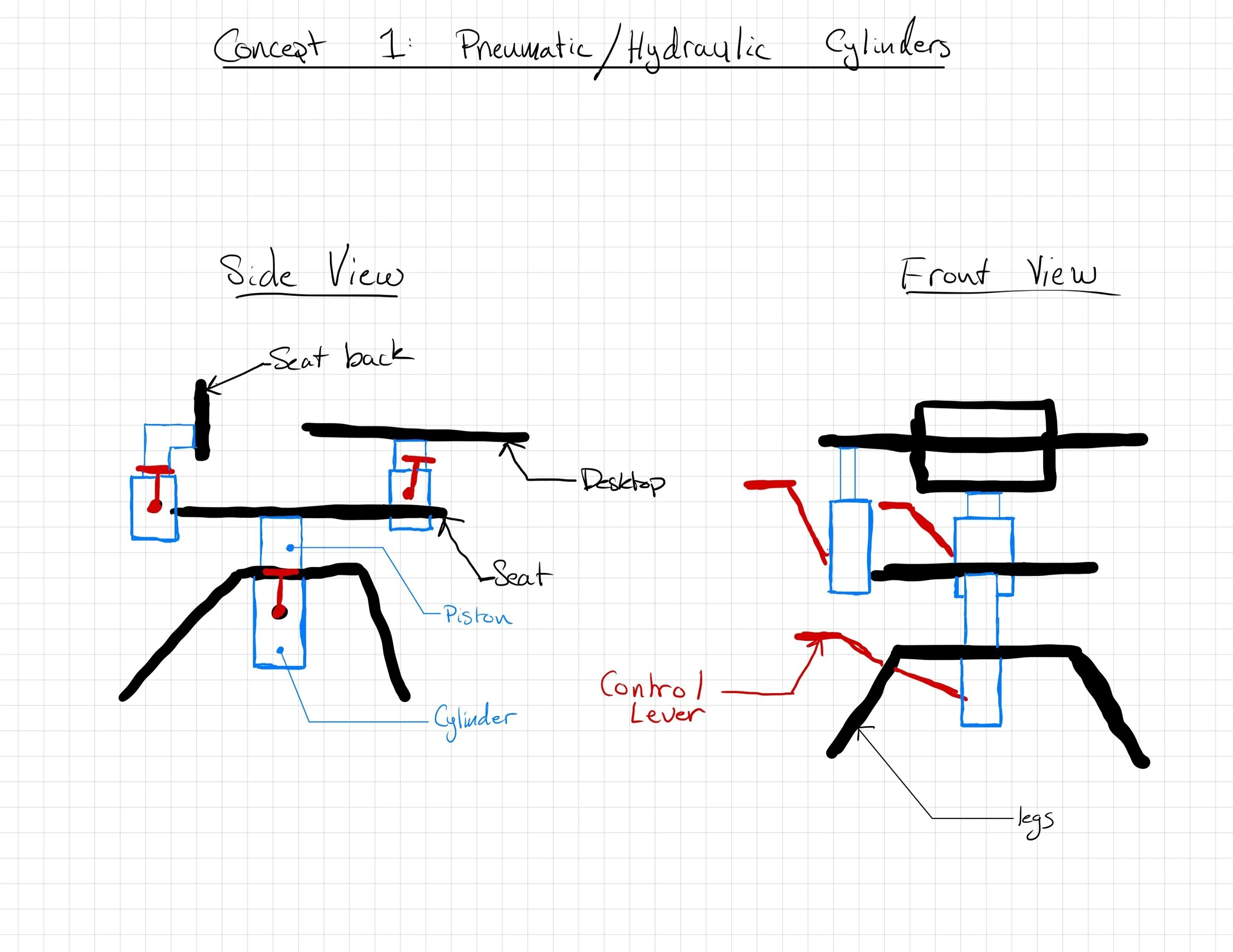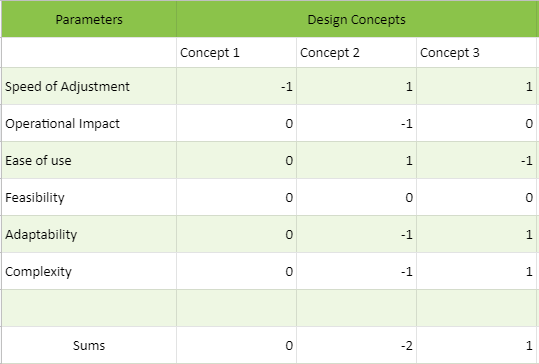Classroom of the Future
Identify a problem or limitation in a Boston University classroom and improve upon it.
Current State of Affairs
Many desks in the BU seminar classrooms are designed to be one size fits all. This means that while students come in many shapes and sizes, the desks that they are required to sit in do not. Students are often required to sit in poorly shaped and improperly sized desks for long periods of time. The discomfort students experience in these desks makes it difficult for them to focus on the work they’re doing and hinders the retention of knowledge
Limitation
Desks are not adjustable.
Objective
Design a system that allows for desks at BU to be made adjustable
Goals
Allow seat height, desk height, and backrest height to be adjusted by user
Minimal operator input required to make adjustments, ideally less than two control surfaces per desk
Design can be implemented on current desks in circulation to reduce implementation cost
Discrete packaging and simple design, ideally less than three moving parts
Constraints
No more than $100/student
Able to prototype in EPIC
Problem Statement
Desks and chairs in classrooms at BU are currently uncomfortable, and they hinder students’ class participation and learning. To improve comfort for students, desks may be modified to allow for adjustment so they better suit the size of the user. The modifications must allow for adjustment of the back rest, desktop, and seat height of the desk with minimal user effort. The system can cost no more than $100/desk to implement, and it must be able to be prototyped in EPIC. Ideally, the system should also be mechanically simple, quiet, and easy to manufacture and assemble. The intended userbase for this design would be students at Boston University.
Benchmarking
Smith Classroom Seating Systems
Smith systems is a classroom equipment manufacturer. I consulted a sales pamphlet to help understand what they emphasize in integrated desk design. When it comes to seating, Smith emphasizes range of motion and the ability to perform a variety of functions while sitting. When they design desks and tables, Smith also focuses on providing a robust work surface.
I also observed that for integrated desks, Smith did not provide any variety in size. This makes sense since it’s cheaper to manufacturer a smaller range of components. However, this is what inspired me to provide adjustment to the integrated desks to improve comfort.
Another thing that I observed in Smith’s sales brochure was that they employed locking pin/rack systems to allow for height adjustment on tables.
Handicap desks in CAS
A real world example of adjustable desktops that BU already implements are the handicap lecture desks in CAS. As demonstrated in the video below, the desk can be adjusted up or down simply by pressing a labeled button. These desks use hydraulic piston/cylinders that are powered by a fluid pump. The drawbacks of these desks is that they are slow and noisy and they require power to operate, so it wouldn’t be a feasible solution for students’ desks. However, the design did inspire me to use a piston/cylinder setup and to allow for desktop adjustment
Adjustable Office Chairs
In the office where I work, the chairs are extremely comfortable. Not only are they cushioned, but they are able to adjust in a variety of ways to suit user preference. By observing the methods with which these chairs are able to be adjusted, I was able to determine possible solutions to creating an adjustable desk.
Operation of Office Chair
Conceptual Design
Concept I: Piston/Cylinder Adjustment
The first design concept will consist of a premade piston/cylinder assembly retrofitted into key areas of the desk to allow for adjustment. Similar to office chairs, the user can use a lever to increase or decrease the displacement of the piston to adjust the desk. This concept is good because it gives the user a mechanical advantage, so they can adjust the seat height while they’re sitting down. The design is very easy to implement, quiet, and simple to operate. Unfortunately, the drawback of the design is that the adjustment speed is likely to be quite slow and requires repetitive motion to control, so it can be annoying to operate. The range of motion is also limited by space.
Concept II: Linear Ratchet
This concept employs the use of a custom-made ratcheting system to control the position of the headrest, seat height, and desktop. A sleeve is used to hold a sliding mechanism which attaches to the part of the desk being adjusted. The slider has notches running along its length, and the sleeve is equipped with a locking mechanism that fits into the notches to hold the slider in place. The locking mechanism can be released by pulling a lever. This design is advantageous because it allows for almost instantaneous adjustment of the desk components, and it’s simple to operate; the ratchet can be released by simply pulling on a handle. On the other hand, ratcheting systems are notoriously noisy. The locking mechanism also has several unique parts, so it may be more difficult to design and manufacture. In addition, the ratchet doesn’t provide the user with a mechanical advantage, so the user cannot adjust seat height while they’re sitting down. Fortunately, this isn’t the case for seatback and desktop adjustment.
Concept III: Rack and pin
Similar to concept II, concept III uses a sleeve and slider (rack) to allow for adjustment in one direction. However, instead of using a ratcheting mechanism to lock the desk in place, this design would use a simple pin that can be slid into the sleeve to hold the slider in place. The rack will have several holes to allow for a wide range of adjustment. In addition, the pin would have to include a mechanism to ensure that it doesn’t slide out inadvertently Like concept II, this design allows for almost instantaneous adjustment of the desk but does not provide mechanical advantage to the user. The rack and pin method of locking is also quiet and very simple to operate. In addition, the concept uses very few parts and would require only a small amount of manufacturing to adapt to current desks at BU.
Preliminary Design
Based on the goals for this design, it’s determined that the rack and pin concept is the most suitable for implementation; however, the piston/cylinder is probably more suitable for seat height adjustment if mechanical advantage is desired. The concept combines ease of use for the user and simplicity of design to get the best of both. Below is a Pugh chart detailed how design parameters were evaluated.
Pugh Matrix
Strategy for Change of Behavior
To encourage students to use the adjustable features, a label will be to the top of the desk that demonstrates various positions the desktop, back rest, and seat height could assume. In addition, the desk could also be labeled with basic pictographic instructions. Both of these strategies are intended to support conscious action of the user.
Parameters
Speed of Adjustment: How fast can the desk be adjusted
Operational Impact: How discreet is the adjustment method
Ease of use: How easily can the desk be adjusted by the user
Feasibility: Estimated difficulty to reach a functional design
Adaptability: How easily could the design be implemented to existing desks
Complexity: How many parts might the system need




